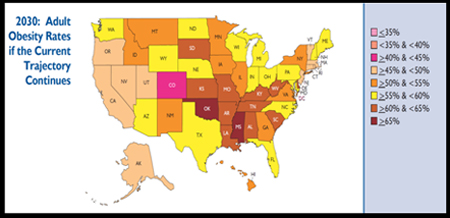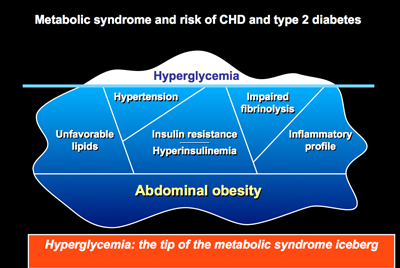
Trajectory of Adult Obesity Rates in the U.S project Virginia to be 50%-55% Obese by 2030. Research shows obese children are very likely to become obese adults.
Arthur Weltman presented “Obesity in Children and Adolescents: Effects of Lifestyle Intervention” at the September’s Works In Progress Meeting.
Related posts are available under Research, Works In Progress Meetings, Health
Key Points from Weltman’s Talk:
- Obese youth who do not show signs for Metabolic Syndrome are still at risk for several health conditions. A Type 2 diabetic diagnosis is just “the tip of the iceberg” with many health problems lying below the surface. There is a constellation of risk factors are already there.
- Sixth grade girls spend over 55% of their time in sedentary behavior (e.g., watching TV in most cases.) (Pate et al. 2006).
- Sedentary behavior is associated with lower academic achievement, lower pro-social behavior and lower self esteem
- Obese children and adolescents become obese adults, so engagement around diet and exercise at an early age is important.
- Fat is an endocrine organ. Storing unfavorably (e.g., too much of it, etc.) affects the body in many ways, including vessel health, increased inflammation, risk for stroke
- Drug therapy (Metformin) improved weight loss and reduced abdominal adiposity, but did not enhance the beneficial effect of diet and exercise on markers related to inflammation, thrombosis, or hepatic fat in obese children with normal glucose tolerance.
- Diabetes is the fastest growing disease in the world and among children
- With regard to social networks, physically active people socially network with other physically active people. Obese individuals socially network with other obese people. We know little about how kids influence other kids to do positive things. Is exercise contagious? (e.g., We do know delinquent kids influence good kids negatively, more than the converse).
- Visceral Fat (abdominal fat is the best measure we have to gauge this) predicts higher health risks.
- Treatment of uncomplicated obesity should continue to focus on lifestyle intervention with intervention programs designed to improve aerobic fitness (three days of week should be vigorous)
- Does Glutamine supplementation after exercise, create nocturnal hypoglycemia in Type 1 diabetic children? Weltman is currently studying this relationship.
Professional and Community Resource: Exercise Physiology Core Laboratory
-
- “Leave all the afternoon for exercise and recreation, which are as necessary as reading. I will rather say more necessary because health is worth more than learning.” – Jefferson
One of the attendees, Nikki Godine, YN Research Technician, writes her impressions of the talk.
Related posts are available under Works In Progress, Research
Art Weltman’s talk addressed, in my opinion, one of the most important health issues in America – obesity and the health problems that go with it. It seems like we’re inundated with so much information about the obesity problem in America, and the importance of diet and exercise, that it’s easy to shrug off the importance of this topic. Lots of Americans are obese – so what, we already know that; we hear it all the time. What I didn’t know was just how many Americans are considered obese, and how that number has changed drastically in less than two decades. For example, over a quarter of Virginia’s population is currently considered obese – that’s one in every four people.
Compared to data from the late 1980s, which showed that between 10 and 14% of Virginia’s population was considered obese, that number seems pretty big – and it’s even more alarming considering how much it has increased in less than 20 years. This is the case all over America – at least 20% of the population in each state is considered obese, which is a huge increase in a short amount of time. In some states, particularly southeastern states, over 30% of the population is considered obese. If obesity rates keep growing at this rate, by 2030 over half of Virginia’s population will be considered obese, and in some states over 65% of the population will be considered obese!
Those numbers are pretty astounding. But the issue of obesity is bigger than numbers and percentages – it’s also important because it affects the health of so many people in many different ways. Obesity isn’t just about having a lot of extra body fat; it’s also about the potentially life-threatening health concerns that are linked to obesity, such as diabetes, hypertension, and cardiovascular disease. So, what can be done about obesity in Americans? The good news is that prevention and treatment doesn’t have to be complicated or expensive. Lifestyle changes, such as a healthy diet and 150 minutes of moderate to vigorous exercise per week, can keep you at a healthy weight, or can lead to significant weight loss for those who are overweight or obese.
Certain medications can also be effective in terms of weight loss when combined with diet and exercise, but these medications don’t provide any benefit beyond what diet and exercise provide. Weight concerns, though, are only one part of obesity – risk factors for health issues such as hypertension, diabetes, and cardiovascular disease are very real, potentially life-threatening concerns associated with obesity, and should also be targeted when tackling the problem of obesity.
The same interventions for weight loss can also work well for reduction of these health issues – both diet/exercise and diet/exercise/medicine can reduce the likelihood of insulin resistance and blood clots, for example.
However, it’s important to note that medicine doesn’t have any effect on the reduction of health issues beyond what diet and exercise already contribute. In other words, taking medication isn’t going to significantly help the health problems associated with obesity; lifestyle interventions such as diet and exercise are your best bet for treatment of problems associated with obesity.
That’s the good news – prevention and treatment of obesity is fairly uncomplicated and can be inexpensive. The bad news is that a lot of people don’t take advantage of these relatively simple preventative practices – it’s hard to get people to exercise and eat healthy.
Looking forward, the next questions become: What can we do to get people to exercise and eat healthy? Why aren’t they motivated to do these things? For those who exercise and eat healthy, what motivates them to do that?

